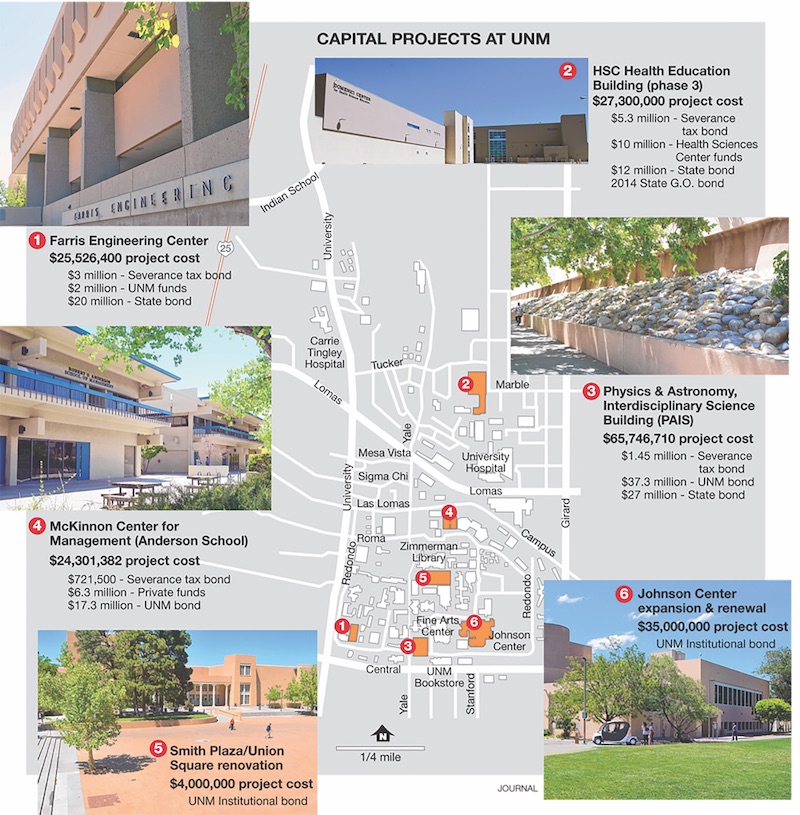Campus construction and renovation projects often come with hefty price tags. A few years ago, Duke University spent nearly $80 million on a new dining hall. Two recent projects that SmithGroupJJR designed include the $50 million Mike Ilitch School of Business at Wayne State University, now under construction in downtown Detroit, and the $82 million, 188,000-sf University of Wisconsin–LaCrosse Instructional Science Facility, a combination of allied health and STEM that will open next year.
As colleges sign off on ever-more-extravagant physical plant to help in their recruitment efforts, tuition hikes are putting college beyond the financial reach of the high school students they are trying to attract.
But colleges and universities are adept at tapping a variety of sources—taxpayers, investors, donors, and, yes, students—to fund their growth ambitions.
Bonds are one time-tested route. The University of New Mexico’s five-building construction program is being paid for primarily with bonds. Last year, North Carolina completed a $2 billion issue of Connect Bonds, $1.33 billion of which are earmarked for the 17 colleges in its UNC system.
Other colleges are asking their student bodies to approve annual user fees that would defray the cost of planned construction and renovation before the work gets started.
 The University of New Mexico’s five-building construction program is being financed by a combination of bonds, student fees, school funds, and private donations. Courtesy University of New Mexico.
The University of New Mexico’s five-building construction program is being financed by a combination of bonds, student fees, school funds, and private donations. Courtesy University of New Mexico.
State governments are also willing to finance college construction, albeit on a limited basis. Supplemental funding by the Massachusetts State Legislature helped pay for the $52 million, 87,500-sf Design Building at the University of Massachusetts Amherst, which had its official ribbon cutting in April. This is the first cross-laminated timber academic building in the U.S.
Greggrey Cohen, Simpson, Gumpertz & Heger’s National Practice Leader for structural repair and rehabilitation, who worked on the UMass Design Building, says that in recent years there has been a “big push” among colleges and universities in the Bay State to replace older buildings.
“The underlying strategy of our capital plan is to target investment in the areas of the highest impact, while balancing these investments across deferred maintenance, modernization, and new construction,” says Shane Conklin, UMass’s Associate Vice Chancellor for Facilities and Campus Services. Construction projects scheduled to open in the next two years include the relocation of a physical sciences building that will be integrated with a new 95,000-sf research building for chemistry and physics.
This isn’t to say that colleges and universities have unlimited access to capital. And their “reno-first” inclinations are a sign of their budgetary constraints.
“Everyone is still money conscious,” says Robert Quigley, of Architectural Resources Cambridge. His firm went through numerous meetings with Bentley University’s board before its Jennison Hall renovation budget got approved. “They are also conscious of the mistakes they made in the past being cheap,” he says. “They want to do a quality job.”
Related Stories
| Aug 11, 2010
Putting the Metal to the Petal
The Holocaust and Human Rights Center of Maine was founded in 1985, but the organization didn't have a permanent home until May 2008. That's when the Michael Klahr Center, which houses the HHRC, opened on the Augusta campus of the University of Maine. The design, by Boston-based architects Shepley Bulfinch Richardson & Abbott, was selected from among more than 200 entries in a university-s...
| Aug 11, 2010
Bronze Award: Alumni Gymnasium Renovation, Dartmouth College Hanover, N.H.
At a time when institutions of higher learning are spending tens of millions of dollars erecting massive, cutting-edge recreation and fitness centers, Dartmouth College in Hanover, N.H., decided to take a more modest, historical approach. Instead of building an ultra-grand new facility, the university chose to breathe new life into its landmark Alumni Gymnasium by transforming the outdated 99-y...
| Aug 11, 2010
High-Performance Modular Classrooms Hit the Market
Over a five-day stretch last December, students at the Carroll School in Lincoln, Mass., witnessed the installation of a modular classroom building like no other. The new 950-sf structure, which will serve as the school's tutoring offices for the next few years, is loaded with sustainable features like sun-tunnel skylights, doubled-insulated low-e glazing, a cool roof, light shelves, bamboo tri...
| Aug 11, 2010
Fleet Library, Rhode Island School of Design
When tasked with transforming an early 1920s Italian Renaissance bank building into a fully functional library for the Rhode Island School of Design, the Building Team for RISD's Fleet Library found itself at odds with the project's two main goals. On the one hand, the team would have to carefully restore and preserve the historic charm and ornate architectural details of the landmark space, d...
| Aug 11, 2010
Cronkite Communication School Speaks to Phoenix Redevelopment
The city of Phoenix has sprawling suburbs, but its outward expansion caused the downtown core to stagnate—a problem not uncommon to other major metropolitan areas. Reviving the city became a hotbed issue for Mayor Phil Gordon, who envisioned a vibrant downtown that offered opportunities for living, working, learning, and playing.







